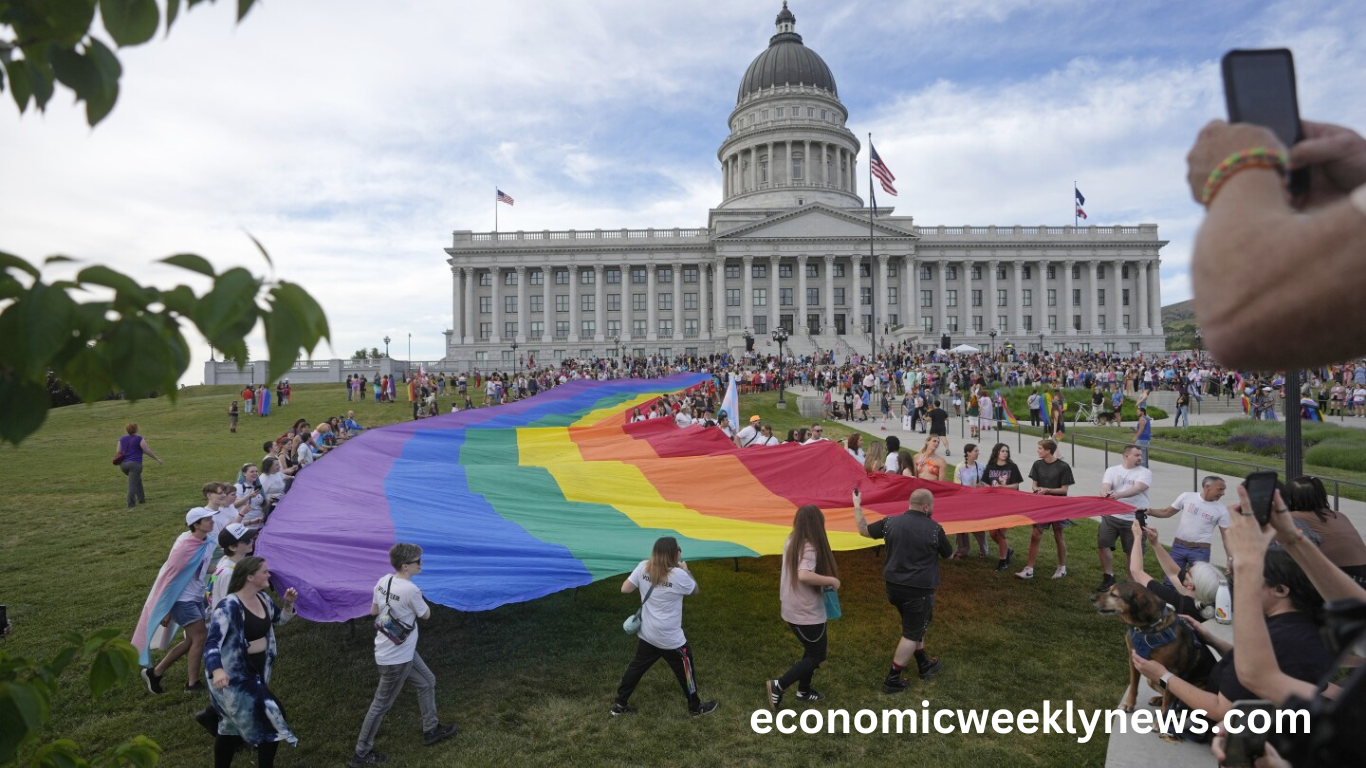In a landmark decision, Utah has become the first state in the United States to prohibit the display of LGBTQ+ pride flags in public schools and government buildings. This legislation, which takes effect on May 7, 2025, has sparked a wide range of reactions and discussions about political neutrality, freedom of expression, and the rights of LGBTQ+ communities.
Legislative Background
The bill, sponsored by Republican Representative Trevor Lee and Senator Dan McCay, aims to promote “political neutrality” within educational and governmental institutions. Under the new law, only specific flags are permitted to be displayed, including the United States flag, the Utah state flag, military flags, and a select few others approved by lawmakers. Buildings that violate this law by displaying unauthorized flags will face fines starting May 7.
Governor’s Stance
Governor Spencer Cox allowed the bill to become law without his signature, expressing reservations about its scope but acknowledging that a veto would likely be overridden by the Republican-controlled Legislature. He emphasized the importance of political neutrality in classrooms but also voiced concerns about the law’s potential overreach and its impact on local governance.
Local Government Response
Salt Lake City, known for its vibrant LGBTQ+ community, has been particularly vocal in its opposition to the new law. City officials have illuminated the Salt Lake City and County Building with rainbow lights each night since the Legislature passed the bill, symbolizing their protest. Andrew Wittenberg, a spokesperson for Mayor Erin Mendenhall’s office, stated that city attorneys are evaluating the law to determine the appropriate course of action once it takes effect.
Implications for the Sundance Film Festival
The passage of this legislation has also raised concerns about the future of the Sundance Film Festival in Utah. The festival, renowned for its support of independent and diverse cinema, including LGBTQ+ narratives, announced its relocation to Boulder, Colorado. While festival leaders stated that state politics did not directly influence their decision, they did consider “ethos and equity values” in their search for a new home, suggesting that the legislative environment played a role.
Read More : FDA’s Top Vaccine Scientist Dr. Peter Marks Steps Down
National Context
Utah’s decision aligns with a broader national trend of regulating flag displays in public institutions. Similar measures have been enacted or proposed in states like Idaho and Florida, reflecting ongoing debates about the display of symbols associated with political or social movements in public spaces.
Criticism and Concerns
Opponents of the law argue that it effectively erases LGBTQ+ expression and undermines the visibility of marginalized communities. Critics contend that promoting political neutrality should not come at the expense of inclusivity and recognition of diverse identities. The American Civil Liberties Union (ACLU) of Utah has expressed concerns about the law’s implications for free speech and the potential for it to marginalize LGBTQ+ individuals further.
Supporters’ Perspective
Proponents of the legislation maintain that it is a necessary step to ensure that public institutions remain neutral spaces, free from political or ideological influences. They argue that the law applies uniformly to all non-sanctioned flags, not solely those representing LGBTQ+ pride, thereby upholding a standard of neutrality across the board.
Potential Legal Challenges
The enactment of this law may face legal challenges on the grounds of free speech and equal protection under the Constitution. Legal experts suggest that prohibiting the display of certain flags while permitting others could be viewed as a form of viewpoint discrimination, potentially leading to court battles over the law’s validity.
Impact on Educational Institutions
For schools, the law mandates the removal of LGBTQ+ pride flags from classrooms and campuses, which may affect the sense of inclusivity and support for LGBTQ+ students and staff. Educators and administrators are now tasked with navigating the balance between complying with the law and fostering an environment that respects and acknowledges the diversity of their student bodies.
Community Response
The LGBTQ+ community and its allies have organized protests and campaigns to express their opposition to the flag ban. These actions highlight the deep divisions and strong emotions surrounding the legislation, as well as the ongoing struggle for visibility and acceptance within the state.
Frequently Asked Questions
What is the main purpose of the new Utah flag law?
The law is intended to promote political neutrality in public schools and government buildings by limiting the display of non-official flags, including LGBTQ+ pride flags.
When does the law take effect?
The law is set to take effect on May 7, 2025.
What flags are still allowed under this law?
Permitted flags include the U.S. flag, the Utah state flag, military flags, and other flags explicitly approved by lawmakers.
What are the consequences for violating the law?
Public institutions that display unauthorized flags may face fines, though specific penalties have not been detailed.
How has the LGBTQ+ community responded?
The community has organized protests, legal challenges, and advocacy efforts to oppose the legislation and highlight its impact.
Can local governments challenge the law?
Local governments, like Salt Lake City, are currently reviewing legal options, but any challenge would likely need to be decided in court.
Does the law apply to private institutions or businesses?
No, the law only applies to public schools and government buildings; private businesses and institutions are unaffected.
Is this law similar to those in other states?
Yes, similar legislation has been enacted or proposed in states such as Idaho and Florida, reflecting broader debates on political neutrality in public spaces.
Conclusion
The ban on LGBTQ+ pride flags in Utah’s public schools and government buildings represents a significant shift in state policy. It has sparked debate over neutrality, free speech, and inclusivity. Supporters see it as a step toward uniformity in government spaces, while opponents argue it suppresses expression. As the law takes effect, legal challenges and public discourse will shape its long-term impact on the state and beyond.

